Introduction
Back in the dark ages of PC gaming, when MS-DOS was the usual platform and the mouse was an optional affair, one had two choices for getting sound out of the PC. Choice one: get a Sound Blaster card, and let the games do their thing mostly unassisted. Choice two: get another card and try to trick your system into thinking that it was a Sound Blaster. Things have gotten considerably better since that time; modern OSes provide an audio API that allows games to handle sound input and output without having to care about what sound system you have under the hood. Cue the rise of onboard audio, and the demise of add-in sound cards as a requirement for a gaming PC.
There’s still a place for sound cards in the modern PC market, though. Maybe you need a low-latency sound system with a dedicated APU for professional audio creation. Maybe you want a gaming-oriented card with lots of extra post-processing effects for 3D sound. Maybe your onboard audio just has an unacceptably high amount of line noise, and you want to kill the hiss or whine coming out of your speakers. For these reasons, the add-in sound card is here to stay.
Talking of games, Creative decided to put together a sound card based on their X-Fi platform, designed to improve the gaming experience. Having done this, they sought and obtained an endorsement deal for this card with someone they feel the PC gamer crowd would respect, one Johnathan ‘Fatal1ty’ Wendell. The result is the lengthily named Creative Sound Blaster X-Fi Titanium Fatal1ty Professional Series sound card, which we’ll be reviewing today.
Before we begin, let’s see what Creative have to say about this card.
Creative’s Take
Get the Pro Gamer’s Choice for Sound
Realistic EAX® 5.0 sound effects that pull you into the game
Accurate 3D positional audio – even with headphones
Accelerated audio for unbeatable game performance
Clearer voice chat for better voice communications
Works with PCI Express equipped PCsChosen by professional gamers, the PCI Express Sound Blaster X-Fi Titanium Fatal1ty Professional Series sound card delivers the ultimate PC gaming audio experience. You’ll hear realistic EAX® 5 sound effects and 3D positional audio that’s so accurate you can locate opponents by sound – even over headphones. Plus, get unbeatable performance in your games with hardware accelerated audio and X-RAM.
Sound Blaster X-Fi is Fatal1ty’s Choice for Audio!
www.fatal1ty.com “When I’m competing I need top-notch performance and the most realistic sound to help me know where my opponents are and Sound Blaster X-Fi really delivers for me…there is nothing faster or better.”Johnathan “Fatal1ty” Wendel is the best-known professional gamer in the world with 38 1st place wins in nine years of tournament play.
Features
Realistic EAX® 5.0 sound effects in games
Hear crackling gunfire and earth-shattering explosions, EAX® 5.0 delivers sound effects that pull you into the game.
Accurate 3D positional audio with X-Fi CMSS®-3D
Locate enemies by sound alone – you’ll get amazing surround sound, even with normal stereo headphones.
Dolby Digital Live encoding
Connects directly to your home theater system through a single digital cable for compelling 5.1 surround sound.
Hardware accelerated performance
Get unbeatable performance in your favorite games with hardware accelerated audio that blows motherboard audio away.
X-RAM
Boost performance even further in games like Quake 4, Battlefield 2, Prey, Unreal Tournament 3 and others that take advantage of X-RAM.
Clearer voice chat
Plug in your headset or microphone and hear the difference. With high quality inputs and hardware audio processing, your teammates will hear you loud and clear.
Cinematic surround sound from DVD movies
Watch your DVDs in cinematic surround sound with PowerDVD software featuring DTS™ and Dolby Digital®-EX decoding.
X-Fi Xtreme Fidelity Perfect for music
Make all of your music sound better with Xtreme Fidelity audio technology that restores the detail and clarity to compressed music files like MP3s.
Record your own music
PCI Express Sound Blaster X-Fi Titanium has fantastic inputs and low-latency ASIO drivers for great music recording.
Specifications
Technical Specifications
- 24-bit Analog-to-Digital conversion of analog inputs at 96kHz sample rate
- 24-bit Digital-to-Analog conversion of digital sources at 96kHz to analog 7.1 speaker output
- 24-bit Digital-to-Analog conversion of stereo digital sources at 192kHz to stereo output
- 16-bit to 24-bit recording sampling rates: 8,11.025,16, 22.05, 24, 32, 44.1, 48 and 96kHz
- ASIO 2.0 support at 16bit/44.1kHz,16-bit/48kHz, 24-bit/44.1kHz 24-bit/48kHz and 24-bit/96kHz with direct monitoring
- Enhanced SoundFont support at up to 24-bit resolution
- 64MB of X-RAM
- Analog output Signal-to-Noise Ratio (A-weighted): 109dB
Connectivity
- Line in / Microphone in (shared 1/8″ mini jack)
- Speaker out (4x 1/8″ mini jacks)
- Optical out (TOSLINK)*
- Optical in (TOSLINK)
- Intel HD Audio Compatible Front Panel Header (2x5pin)
* Optical Out supports stereo SPDIF out, multichannel out via Dolby Digital Live, and pass through of multichannel DVD sound
Speaker Support
- Stereo/2.1 Speakers
- 4/4.1 Speakers
- 5.1 Speakers
- 7.1 Speakers
- Headphones
Bus Connection
- PCI Express 1x
Packaging
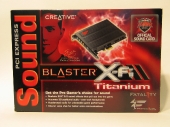
Creative have elected to go with an aggressive design here, though one that thankfully avoids the silly random CGI of many product packages. Right away, you know that this is a Sound Blaster card, it’s meant for gamers, and it’s endorsed by this “Fatal1ty” fellow.

On the back, we get the usual laundry list of features and logos. Good use of bullet lists and bounding boxes to keep things readable here, which is a plus.
On one side, we get a look at the card’s faceplate, with all the ports labeled by function. This is actually fairly useful, given the somewhat unusual layout of ports. On the other side, we have a testimony from Mr. Wendell.
Opening things up, we see the card itself front and center, wrapped in plastic and wedged into a cardboard insert to hold it in place. With the packaging discarded, the contents of the box are pretty basic: the card itself, a driver and software disc, and a quick-start guide. As has become the norm, no printed manual is included.
A Closer Look
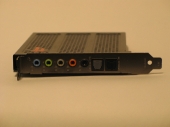
Turning the card on its side, we see the faceplate that will show up at the rear of your computer’s case when the card is installed. The usual complement of analog speaker jacks is present, though on this card the microphone and line-in jacks have been combined into a single “multi-in” jack. Whether the jack behaves as a microphone or line-in jack is controlled in software. Next to these are the two TOSLINK optical ports: one in and one out. This card has the ability to accept a full 5.1 digital audio stream and pass it through to the speakers, which is quite nice if you have a game console or blu-ray player that you want to use alongside the computer.
On the opposite side from the faceplate, we see the internal headers. The enclosed header on the left is for CDDA passthrough from an optical drive, and the bare header on the right handles front-panel connections. This header has more pins than usual, as this card is designed to be used with an optional I/O headunit that sits in a 5.25″ drive bay. A standard front-panel header also works, if you want to use that instead.
Testing
Testing was conducted with the following setup:
CPU: AMD Phenom II X4 905e @ 2.50 GHZ
Motherboard: Gigabyte MA785GPMT-UD2H
Heatsink: GlacialTech F101
RAM: 2×2GB Crucial Ballistix DDR3-1333, 9-9-9-24 default timings
HDD1: Seagate Barracuda 7200.10 500GB SATA-II; single-drive mode
HDD2: Western Digital Caviar GreenPower 500GB SATA-II (5900RPM); single-drive mode
GPU1: ATI Radeon HD 4830, 512MB GDDR3 memory
Sound: Creative Labs X-Fi Titanium Fatal1ty Professional Edition
- Speakers: Klipsch ProMedia 2.1 THX
- Headphones: Sennheiser HD280 Pro
- Microphone: Radio Shack headset microphone, model 33-3012
Case: Silverstone FT-01 Fortress
OS: Windows 7 Ultimate 64-bit
Drivers: Catalyst 9.10
Testing on a sound card is normally a highly subjective affair, as there are quite a few elements that contribute to sound quality. Given the somewhat unique nature of this card’s gaming enhancements, however, we’ll be taking a brief look at how this card affects a game’s performance.
Each set of tests was conducted twice, once with speakers and once with headphones. Voice chat tests were also conducted this way, with a headset microphone used for input. Front panel inputs were tried early on, but rejected as they introduced an unacceptable amount of line noise. As the same results obtained with the front-panel header plugged into the onboard audio of two different motherboards, the fault there lies with the panel, rather than the sound card.
Music
Music testing was conducted with the songs featured in the clip above. The source files range in quality from a few heavily compressed MP3s to several high-quality lossless CD rips. The Creative drivers have a notion of mode-switching, with one mode for music and movies and another for games. No audible difference was detected in either mode.
The main enhancement of interest here is the X-Fi Crystalizer, which Creative says can “restore lost detail” in compressed recordings. While this is a blatant lie, the crystalizer did improve the sound of the more heavily-compressed tracks. A similar improvement was gained with the crystalizer off by careful EQ tweaking in the player software, but this required constant tweaking as the source format and musical genre changed throughout the playlist.
Regardless of effects or EQ tweaks, sound was crisp, clear and distortion-free, no matter how loud or soft it was played.
Games
Anybody putting down the cash for a sound card with Fatal1ty’s name on it is obviously doing it for the benefits it brings to gaming. While just about any modern game can benefit from hardware-accelerated EAX effects, the bit that sets this card apart from the pack is the X-RAM. Simply put, this card has 64MB of onboard memory that supported games can use to offload audio processing chores. The game has to use the OpenAL framework to take advantage of X-RAM, which limits the available pool rather sharply. Most Unreal Engine-based games do use OpenAL however, which suggests an obvious candidate…

Since X-RAM is automatically used whenever an OpenAL program is running, the only way to test its effect was to switch between the X-Fi and the motherboard’s onboard audio. Testing was done by playing through a timedemo of a 16-player deathmatch, once with each sound system. EAX was disabled in both tests, to keep things consistent.
The X-RAM does appear to make a difference, though hardly a huge one. The real benefit of the X-Fi card in this scenario lies with the CMSS-3D effect. Through some on-the-fly manipulation of the sound, the card can simulate the effect of a full 7.1 surround sound speaker set with only two speakers or a pair of headphones. With this feature enabled, positional audio became markedly more distinct, with footfalls and other subtle effects causing me to turn in my seat to see who was trying to sneak up on me.
Voice Chat
 |
 |
This portion of the testing consisted of two long bull sessions, a one-on-one with a friend via Skype, and a 25-way free-for-all over Ventrilo. In both cases, the voices were clear and distinct, even over top of loud background music, game noises, and a noisy pool pump.
Conclusion
The question I hear over and over when discussing this card with friends is this: “Why bother with a sound card at all? Isn’t the motherboard’s sound good enough these days?” Indeed, if you’re not terribly picky about sound quality, you probably won’t notice the difference. To those with a discerning ear, however, the Creative X-Fi Titanium Fatal1ty Pro is certainly worth paying attention to.
The main benefits this card brings to the table are:
- improved 3D audio
- improved sound quality through post-processing
- somewhat improved game performance
- a digital input for streaming surround sound from an external source
If these things are important to you, then the X-Fi Titanium Fatal1ty Pro is definitely worth a look.

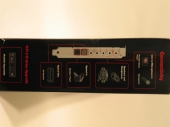
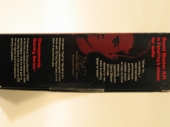
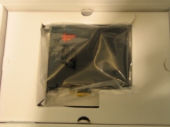
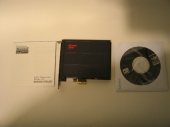
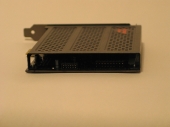
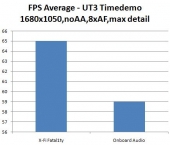

good blog site. many thanks this excellent post. i have fun here a lot.
May I know some other ways to get new drivers from your blog?
@Mythril
And I suppose you did this after cleaning out all traces of old drivers, so there would be no conflicts? Creative’s history with drivers is colorful, true, but I’ve had no issues with it across two different systems–except when I forgot to take out the old sound drivers first.
A lot of times people blame their problems with a new piece of hardware on the supplied drivers, when the real culprit is all the old drivers that have leftover bits and pieces still hooked into the system.
Just something to think about…
What a load of crap. Creatives drivers are utter garbage. I bought one of these cards about a month ago. I had UT3 crashing left, right and centre. Stalker Clear Sky was crashing and so was Fallout 3. Other games I’d tested seemed ok. Ripped out this pos and replaced it with my old sound card. Oh suprise suprise games now not crashing. I bought a Zonar and though thte sound was great the emulated EAX had it’s issues. Stalkers sound was fine apart from not being able to hear my own gun fire. That went back to the shop. Now i’m on a Auzentech Forte 7.1 and EVERYTHING is working the way it should. Just wish Creative could write working drivers !!